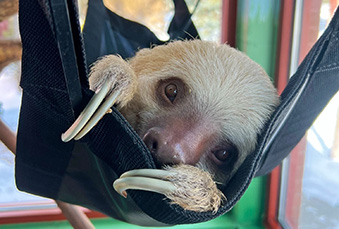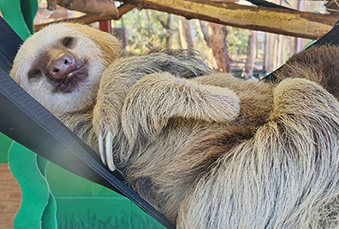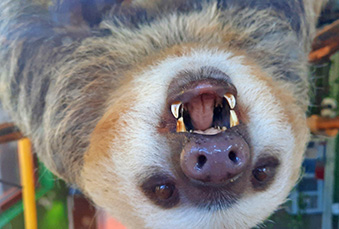Choloepus hoffmanni | Hoffman’s two-toed sloth or two-toed sloth
Name: Elton (Male)



Meet Elton the Hoffman’s Two-toed Sloth
Welcome to the slow lane! Elton, our resident Hoffman’s Two-toed Sloth, might not be in a hurry—but his relaxed rainforest lifestyle is full of incredible adaptations and quiet charm. Native to the tropical forests of Central and South America, this tree-dwelling mammal is a true ambassador for slowing down and savoring life one branch at a time.
Life in the Canopy
Two-toed sloths like Elton are arboreal, meaning they spend nearly their entire lives in the trees. From eating and sleeping to grooming and even giving birth, everything happens while hanging upside down! Their long, curved claws and strong tendons allow them to grip branches effortlessly for hours at a time. In fact, sloths expend almost no energy hanging—it’s what they’re built for.
And they’ve got a skeletal twist to match: while most mammals have 7 neck vertebrae, Hoffman’s Two-toed Sloths can have anywhere between 5 to 8 cervical vertebrae. This variation, along with well-developed neck and shoulder muscles, gives them added flexibility and support while suspended upside down in the canopy.
Slow, Steady—and Surprisingly Smart
Famous for their slow movements, Hoffman’s Two-toed Sloths have the slowest metabolism of any herbivorous mammal. It can take up to 2.5 days to digest a single meal, allowing them to survive on just under a pound of food per day.
This slow digestion comes with a perk: it allows sloths to neutralize many plant toxins that would be harmful to other animals. Their four-chambered stomach—similar to that of cows and other ruminants—is filled with bacteria that help break down tough plant material.
Elton and his wild cousins are folivores, primarily eating:
- Leaves
- Tender twigs and buds
- Flowers and fruit
- Occasionally, small insects for added nutrients
Built for the Rainforest
Elton’s shaggy coat isn’t just adorable—it’s functional. His fur grows from belly to back, helping rainwater run off as he hangs upside down. Even more amazing? His fur supports the growth of algae and moss, giving him a greenish tint that acts as camouflage in the treetops. That’s right—Elton is a one-sloth ecosystem!
Hoffman’s Two-toed Sloths are solitary animals, usually only seen together during mating or when a mother is raising her young. They also maintain a lower body temperature than most mammals and regulate it by moving between sun and shade. With very low muscle mass and no ability to shiver, they rely on their environment to stay warm.
Creatures of the Night
Elton is nocturnal, meaning he’s most active at night. He relies heavily on his keen sense of smell to find food. And while sloths aren’t exactly fast movers on land, they’re excellent swimmers, using long arms to move gracefully through water—a handy skill during rainforest floods.
Once a week, sloths descend from the canopy to defecate at the base of their favorite tree—a rare trip that plays a big role in rainforest health. Their waste acts as a natural fertilizer, and amazingly, a single trip can equal 30% of their body weight!
Fact Sheet
Taxonomy
Species: Choloepus hoffmanni
Kingdom: Animalia | Phylum: Chordata | Class: Mammalia | Order: Pilosa | Family: Megalonychidae | Genus: Choloepus |
Favorite Enrichment Type
Hammock, milk crate or other items to hang from/in!
Life Span
- In the Wild: Up to 20 years
- In Human Care: About 30 to 40+ years
Diet
- In the Wild: Leaves, fruits, flowers, and occasional insects.
- At the Zoo: Zupreem® Primate diet, summer squash, carrot, sweet potato, a fruit mix of apple, pear, and grape, as well as romaine lettuce and browse.
Geographic Range
Central America and northern South America
Habitat
Lowland forests and higher altitude rain forests that have a continuous canopy.
Sloth-tastic Facts
- Sloths only come down from trees once a week to go to the bathroom.
- Their necks can rotate up to 270 degrees for a wide view of their surroundings.
- Their fur provides a habitat for algae and insects, creating a tiny ecosystem.
- They are surprisingly good swimmers.
- Their digestion takes more than two days, supporting a low-energy lifestyle.
Status: Least Concern
Breeding and Conservation
Although currently listed as Least Concern, Hoffman’s Two-toed Sloths face growing threats from:
- Deforestation
- Agricultural expansion
- Human development
- Illegal pet trade
Sloths are often taken from the wild to be kept as exotic pets—a practice that is harmful and unsustainable. These animals have very specific habitat, diet, and veterinary needs that cannot be easily met in a home environment.
Want to know more about why sloths don’t make good pets? Visit the Not-a-Pet Campaign to learn how you can help stop this harmful trend.
You can also support sloth conservation by:
- Reducing single-use plastics.
- Buying rainforest-friendly products, like Bird Friendly® coffee.
- Supporting sustainable agriculture and forest-friendly brands.
- Advocating for organizations, like the Saginaw Children’s Zoo, that protect wild animals and their habitats.
Elton is a powerful reminder of the delicate connection between animals and the environment. With his gentle presence and incredible adaptations, he inspires us to protect the forests that countless species—including humans—depend on. Slow down, look up, and do your part to keep the rainforest thriving!
How to Find Me
Elton is at home in our Rainforest Habitat, usually spotted snoozing, nibbling, or hanging out in the treetops. Keep your eyes peeled—he might not move much, but when he does, it’s a sight to see!
